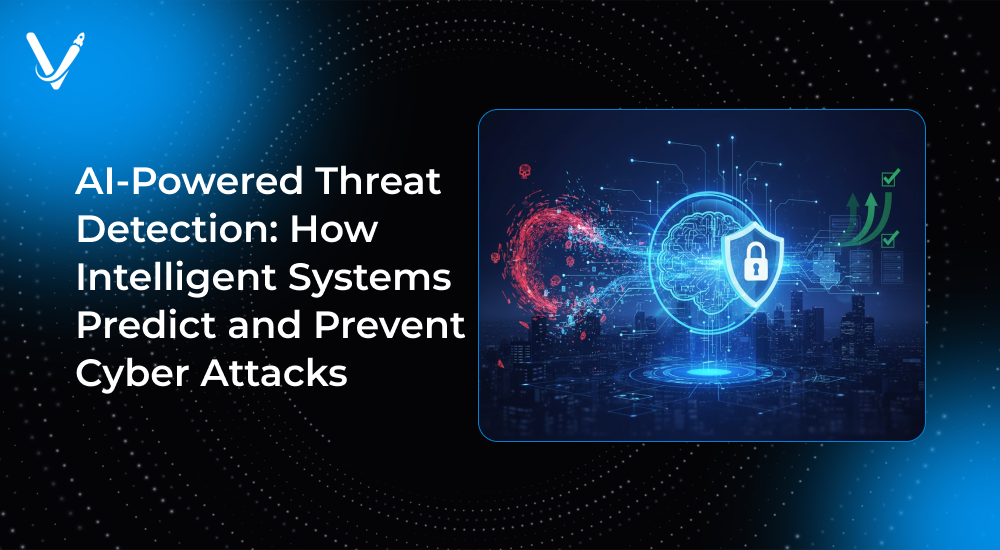AI-Powered Threat Detection: How Intelligent Systems Predict and Prevent Cyber Attacks


- Nov 5, 2025



Key Takeaways
Cyber threats have evolved into one of the most unpredictable challenges of the digital era. Organizations face an environment where attackers innovate daily — crafting advanced phishing schemes, ransomware, and zero-day exploits that traditional defenses fail to catch. Static firewalls and rule-based systems are no longer sufficient to protect sensitive data, customer trust, and brand reputation.
This is where AI-powered threat detection is revolutionizing how businesses safeguard their assets. Instead of reacting after an attack, companies can now predict and prevent it. Intelligent systems analyze millions of data points across networks, applications, and user behavior to identify subtle warning signs invisible to human analysts.
This article explores how AI transforms cybersecurity, how it works in real-world applications, and why forward-thinking businesses are investing heavily in intelligent defense systems. By the end, you’ll understand how AI threat detection not only stops attacks but also gives your organization a measurable competitive advantage in resilience and trust.
Before exploring AI’s role, it’s essential to understand the growing impact of cybercrime. According to multiple industry reports, the global cost of cyber attacks is expected to surpass $10 trillion annually by 2025. Beyond direct financial losses, breaches destroy customer confidence and disrupt entire supply chains.
Small and medium-sized businesses, once thought to be low-risk, are now prime targets. Attackers often exploit outdated systems, weak authentication, or unmonitored endpoints. Even a single compromised account can provide entry into critical systems.
As companies adopt cloud platforms, remote work, and IoT ecosystems, their attack surface widens dramatically. Each new device or application connection creates a potential entry point. Without automated threat detection, monitoring this complex environment manually becomes nearly impossible.
That’s why organizations are embracing AI-driven cybersecurity — not just as a tool, but as a core strategic investment.
AI doesn’t replace cybersecurity teams; it augments their intelligence and speed. Traditional systems rely on predefined rules — for example, blocking an IP known for malicious activity. However, new attack patterns often bypass those rules.
AI uses machine learning (ML) and deep learning algorithms to recognize unfamiliar threats by learning from data patterns. Instead of waiting for signature updates, AI continuously adapts to new tactics.
Here’s how it transforms traditional cybersecurity operations:
This approach makes AI threat detection systems proactive rather than reactive — a critical shift in today’s fast-moving digital landscape.
For business leaders, cybersecurity is not only a technical priority but a financial and reputational one. The value of AI-driven threat detection extends far beyond stopping hackers — it reshapes how companies operate and make decisions.
Manual detection often takes days or weeks. AI shortens that timeline to minutes. Automated detection and triage reduce the time between identification and mitigation, minimizing potential damage. Businesses experience fewer service interruptions and less data exposure.
The financial toll of breaches includes recovery costs, legal liabilities, and brand repair. By catching anomalies early, AI minimizes these losses. It prevents minor security lapses from turning into full-scale incidents.
Data privacy regulations like GDPR, CCPA, and HIPAA require strict monitoring of personal and sensitive data. AI enhances compliance by constantly auditing data movement, flagging suspicious transfers, and maintaining audit trails for regulators.
AI automates repetitive monitoring tasks, freeing human analysts to focus on complex threats. This optimizes manpower and reduces burnout in cybersecurity teams, a growing concern in a field facing talent shortages.
When clients see that your company invests in advanced security, they gain confidence in your digital ecosystem. This strengthens long-term relationships and helps attract new customers in industries like finance, healthcare, and e-commerce.
As businesses expand across geographies, cloud environments, and devices, manual monitoring fails to scale. AI systems adapt seamlessly — learning patterns across hybrid infrastructures and adjusting in real time to protect all endpoints.
In short, AI threat detection isn’t just about cybersecurity — it’s about building business resilience and trust.
What makes AI truly powerful in cybersecurity is its predictive capability. Instead of focusing on attacks that have already occurred, predictive AI models identify risks before they cause harm.
They achieve this through a combination of:
By constantly learning and adapting, AI provides a living, evolving defense mechanism that stays one step ahead of attackers.
AI-driven cybersecurity isn’t limited to tech giants. Businesses across industries are integrating it into their operations to protect both data and customers.
Banks use AI to monitor billions of transactions daily. When unusual spending patterns or login locations appear, AI immediately flags them for review. This prevents fraudulent transactions before money leaves an account. AI also powers credit-risk monitoring, ensuring that fraud doesn’t slip through legacy systems.
In healthcare, patient data is among the most sensitive. AI helps hospitals and clinics detect unauthorized access to medical records, ransomware attempts, or suspicious device connections in connected health systems. Beyond protection, it helps maintain compliance with strict data laws.
Online retailers deploy AI to monitor web traffic, identify fake accounts, and prevent payment fraud. During high-traffic seasons, AI automatically adjusts defenses to handle surges in activity while ensuring real-time threat visibility.
Manufacturing companies increasingly rely on connected sensors, robotics, and smart systems. AI protects these operational technologies (OT) by identifying compromised devices, malware-infected firmware, or irregular machine commands that indicate cyber sabotage.
Cloud service providers and SaaS vendors use AI to detect cross-tenant data leaks, unauthorized API usage, or account takeovers. By monitoring millions of logs and configurations, AI ensures continuous protection across distributed cloud environments.
Each of these examples illustrates that AI-powered security is not an add-on; it’s a strategic enabler for businesses embracing digital transformation.
A common misconception is that AI replaces cybersecurity professionals. In reality, the best systems operate through human-AI collaboration.
While AI handles detection and response automation, human analysts bring contextual understanding, ethical reasoning, and decision-making that machines cannot replicate. Together, they create a dynamic defense strategy:
This synergy transforms security teams into proactive defenders rather than reactive responders. The result is fewer false positives, faster threat resolution, and an adaptive learning loop that gets smarter every day.
The cybersecurity landscape is no longer defined by isolated incidents. Attacks are now automated, sophisticated, and often AI-assisted. Hackers use AI to bypass defenses, generate realistic phishing emails, or evade detection tools.
To counter this, companies must use equally intelligent systems. AI cybersecurity creates a continuous cycle of learning and adaptation, where both attackers and defenders leverage automation.
The future of cyber defense lies in adaptive security architectures — systems capable of self-learning, autonomous decision-making, and cross-environment integration. The next wave includes generative AI for defense simulation, AI-driven penetration testing, and self-healing networks that repair vulnerabilities instantly.
Organizations adopting these innovations early will not only protect themselves but also lead their industries in security maturity and digital trust.
Despite its potential, AI-powered threat detection brings challenges that businesses must manage carefully.
AI systems rely on massive datasets for training and accuracy. Mismanaged data collection can introduce privacy risks. Companies must ensure transparency in how they gather and process user data to train their models.
If AI models are trained on incomplete or biased data, they may generate inaccurate predictions. Regular auditing and model retraining are essential to ensure fairness and reliability in decision-making.
While AI minimizes false alerts, poorly configured models may still overwhelm analysts. Businesses must fine-tune thresholds and integrate feedback loops to maintain a healthy signal-to-noise ratio.
Overreliance on AI can reduce human vigilance. The key is to balance automation with human oversight, ensuring accountability in every security decision.
Cybercriminals are also adopting AI to create adaptive malware and deepfake-based social engineering attacks. Businesses must continuously update and retrain their defensive models to keep up.
By addressing these challenges strategically, companies can harness AI’s benefits responsibly and sustainably.
Implementing AI in cybersecurity is a journey — not a single deployment. It begins with strategic planning and evolves through continuous optimization.
Here’s a roadmap for organizations looking to adopt AI threat detection systems effectively:
This structured approach ensures that AI not only detects threats but aligns seamlessly with business goals, compliance standards, and customer expectations.
Partnering with experts like Vasundhara Infotech helps organizations deploy AI-based cybersecurity systems faster and more effectively. Businesses often lack the in-house expertise or resources to build and train their own AI defense systems. By collaborating with experienced development teams, they gain access to:
AI threat detection is not a one-time purchase — it’s a continuous relationship between technology, people, and processes. Working with a trusted partner ensures your investment delivers measurable protection and long-term ROI.
Companies that integrate AI into their cybersecurity workflows enjoy clear competitive advantages:
In industries where digital trust defines brand value, these advantages directly translate into growth, market differentiation, and investor confidence.
As digital ecosystems evolve, the next frontier of cybersecurity lies in autonomous intelligence. We’re moving toward systems capable of predicting attacks before they even surface in logs. Think of it as a digital immune system — a self-learning network that identifies, isolates, and neutralizes threats instantly.
Emerging technologies like quantum computing, federated learning, and generative AI will further transform how businesses protect their assets. Future AI systems will be able to simulate potential attacks, conduct automated penetration tests, and design countermeasures in real time.
For businesses, staying competitive will mean staying secure — and AI will be the key differentiator in achieving that balance.
The world is entering an era where cyber threats evolve faster than ever. Businesses can no longer rely on reactive defense models. They need intelligent systems that predict, prevent, and adapt continuously.
AI-powered threat detection empowers organizations to achieve exactly that — by blending automation with human insight, by learning from every incident, and by providing real-time visibility across complex digital infrastructures.
Companies that invest in AI cybersecurity solutions today are not only protecting their data but also safeguarding their reputation, revenue, and customer trust for the future.
At Vasundhara Infotech, we help organizations harness AI to transform their cybersecurity posture. Our intelligent solutions are designed to predict risks, enhance resilience, and deliver peace of mind in an unpredictable digital world.
Ready to future-proof your business with AI-powered cybersecurity?
Let’s build your intelligent defense system today. Contact us today.
Copyright © 2025 Vasundhara Infotech. All Rights Reserved.